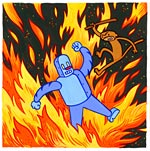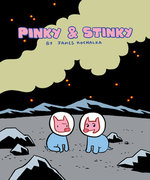library love
March 27, 2006
I was recently forwarded an essay written from the School Library Journal, written by a school media specialist (librarian?) who has discovered how absolutely compelling comics can still be for kids (who generally simply don't have any exposure to comics), and what great educational tools they can be.
It's a wonderfully comprehensive article, easy to understand for the uninitiated, and chock full of anecdotes and recommendations. Including several Top Shelf titles: Owly, Pinky & Stinky, and Monkey vs Robot.
The article was written by Allyson Lyga, and published in School Library Journal Vol. 52, Issue #3, March 2006.
Here are two fabulous excerpts. The first provides an example of her firm grasp of what makes the medium tick, while the second is a testimonial which centers on Andy Runton's Owly.
* Brain Food
I always like to say that, educationally speaking, graphic novels give
the brain more of a workout per sentence than any other type of media,
including conventional books. That's because as a reader takes in a
graphic novel's print and art through a series of panels, word balloons,
and captions, the reader's brain is bombarded simultaneously with the
graphic novel's characters, setting, plot, and action. So if a parent or
teacher claims that reading graphic novels isn't much of a challenge for
a child, hand him one. Explain how the brain works to comprehend the
story and how it detects the subtle nuances of the characters' facial
expressions.
* SINCE I STARTED STOCKING OUR SCHOOL LIBRARY WITH graphic novels six
years ago, I've discovered that kids love them...
Of course not everyone thinks graphic novels are wonderful. Some
teachers, parents, and even media specialists wonder if they're even
appropriate for young students to read. Are graphic novels really worth
purchasing? Or do they just pander to kids' wants without meeting their
educational needs? To best answer those questions, let me share a
typical experience I had with one of our third graders, a below-average
reader named Bryonna.
Bryonna checked out a copy of Owly, one of our most popular graphic
novels, earlier in the year. She came up to me before class and held it
up: "I love this book," she said. "It's my favorite book!", I was
thrilled and wanted to know more. "It's a story about friendship, and
there aren't any words in the book," she told me. "I read the story to
my two-year-old sister, and she loved it, too!", "How did you read a
book without words?", I asked her. Bryonna explained that when she
looked at the pictures she thought about the words the characters were
saying and she visualized the words in her head. Then, when she read the
story to her sister, she created the dialogue and story based on the
pictures.




